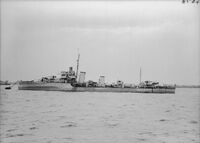
British destroyer HMS Hotspur (H01)tied to a buoy at Sheerness.
HMS Hotspur (H01) was an H-class destroyer built for the Royal Navy during the 1930s. During the Spanish Civil War of 1936–1939 the ship spent considerable time in Spanish waters, enforcing the arms blockade imposed by Britain and France on both sides of the conflict.
In 1939, the Hotspur encountered the German freighter MV Wilhelm Gustloff in the North Sea three miles inside a thirty mile exclusion zone. After the Wilhelm Gustloff refused to stop so that it could be searched, the Hotspur fired a warning shot to try and get the freighter to stop. After that failed, the crew of the Hotspur captured and boarded the Wilhelm Gustloff to search the ship. The freighter was found to be carrying weapons onboard, presumably to Northern Ireland, though that remained uncertain as the captain of the Gustloff destroyed the ship's logs.[1]
In 1941, Hotspur was transferred to Gibraltar. A month later the ship was badly damaged when she rammed and sank an Italian submarine. She received permanent repairs in Malta and was transferred to the Mediterranean Fleet when they were finished in early 1941. Hotspur participated in the Battle of Cape Matapan. Hotspur was transferred to the Eastern Fleet in March 1942.
On November 15th 1942, the Hotspur was in the Pacific assigned to Battle Group Able Two-One where it acted as a decoy to lure the Yamato battle group closer to the a combined allied fleet led by aircraft carriers HMS Illustrious, HMS Formidable, HMS Implacable, HMAS Melbourne, and HMCS Vimy Ridge.[2]
On June 17th 1943, the Hotspur was part of an RN cruiser group that engaged Japanese forces off the coast of North Borneo.[3].
Hotspur was sold to the Dominican Republic on November 2nd, 1948 and renamed ARD Trujillo. By this time the ship carried a Type 291 air warning RDF and a Type 277M air/surface search RDF. Four Bofors 40mm anti-aircraft guns replaced the Oerlikon 20mm AA cannons. She was sold for scrap in 1972.